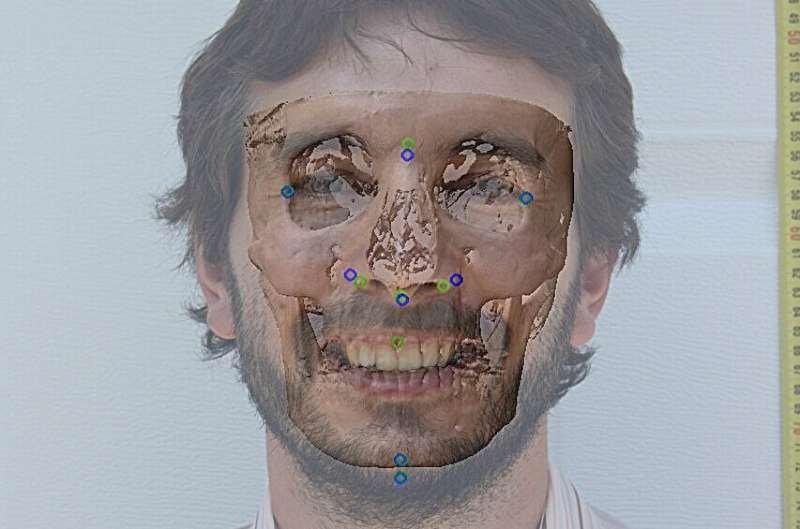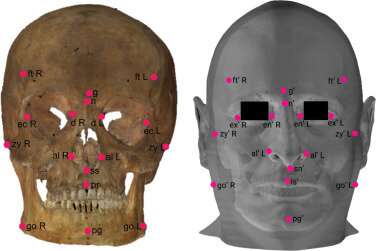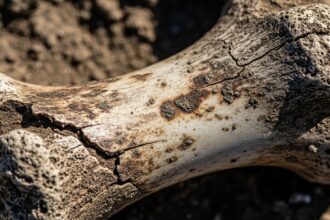The identification of human remains stands as a pivotal challenge, one that demands unwavering precision and objectivity. Craniofacial superimposition, a technique that involves overlaying a recovered skull onto facial photographs of missing individuals, has long been employed to facilitate this arduous process. However, despite its significance, this method has been marred by subjectivity and qualitative reporting, rendering decision-making a complex and oftentimes precarious endeavor.
- Overcoming Subjectivity: The Likelihood Ratio Framework
- Experimental Validation: A Multifaceted Approach
- Experiment 1: Frontal Facial Photographs
- Experiment 2: Lateral Facial Photographs
- Experiment 3: Combining Frontal and Lateral Facial Photographs
- Proof of Concept: A Stepping Stone Towards Practical Implementation
- The Forensic Landscape: A Paradigm Shift
- Collaborative Synergy: A Multidisciplinary Endeavor
- Conclusion: A Beacon of Progress in Forensic Science
Recognizing the urgency to fortify this critical forensic tool, a team of researchers from the University of Granada’s Andalusian Inter-university Institute in Data Information in analog or digital form that can be transmitted or processed. Read Full Definition Science and Computational Intelligence (DaSCI), the University of A Coruña’s Center for Information and Communications Technology Research (CITIC-UDC), and the company Panacea Cooperative Research have embarked on a groundbreaking study, recently published in the esteemed journal Information Fusion.
Information in analog or digital form that can be transmitted or processed. Read Full Definition Science and Computational Intelligence (DaSCI), the University of A Coruña’s Center for Information and Communications Technology Research (CITIC-UDC), and the company Panacea Cooperative Research have embarked on a groundbreaking study, recently published in the esteemed journal Information Fusion.

Overcoming Subjectivity: The Likelihood Ratio Framework
At the core of this pioneering research lies the implementation of a likelihood ratio (LR) framework, a methodology that has proven its mettle in various forensic disciplines, including DNA DNA, or Deoxyribonucleic Acid, is the genetic material found in cells, composed of a double helix structure. It serves as the genetic blueprint for all living organisms. Read Full Definition analysis, voice comparison, and fingerprint examination. Endorsed by the esteemed European Network of Forensic Science
DNA, or Deoxyribonucleic Acid, is the genetic material found in cells, composed of a double helix structure. It serves as the genetic blueprint for all living organisms. Read Full Definition analysis, voice comparison, and fingerprint examination. Endorsed by the esteemed European Network of Forensic Science Discover the fascinating field of Forensic Science, the application of scientific principles to legal matters. This post delves into its many disciplines, from DNA analysis to crime scene investigation, its importance in the justice system, Read Full Definition Institutes (ENFSI), this approach promises to revolutionize the evaluation of evidence
Discover the fascinating field of Forensic Science, the application of scientific principles to legal matters. This post delves into its many disciplines, from DNA analysis to crime scene investigation, its importance in the justice system, Read Full Definition Institutes (ENFSI), this approach promises to revolutionize the evaluation of evidence Evidence is any form of proof, such as objects, materials, or scientific findings, presented to establish or disprove a fact in a legal proceeding. It is used to reconstruct events and link or exclude individuals Read Full Definition in craniofacial superimposition, ushering in a new era of objectivity and quantitative rigor.
Evidence is any form of proof, such as objects, materials, or scientific findings, presented to establish or disprove a fact in a legal proceeding. It is used to reconstruct events and link or exclude individuals Read Full Definition in craniofacial superimposition, ushering in a new era of objectivity and quantitative rigor.
Experimental Validation: A Multifaceted Approach
To validate their innovative system, the researchers conducted a series of three comprehensive experiments, each designed to test the framework’s efficacy under varying conditions. The first experiment utilized frontal facial photographs, while the second employed lateral facial images. In a culminating effort, the third experiment combined both frontal and lateral photographs, providing a holistic assessment of the system’s capabilities.

Experiment 1: Frontal Facial Photographs
In this initial experiment, the researchers trained and tested their likelihood ratio system using frontal facial photographs. The results were remarkable, with the system exhibiting exceptional calibrationThe act of checking or adjusting (by comparison with a standard) the accuracy of a measuring instrument. Operation that, under specified conditions, in a first step, establishes a relation between the quantity values with measurement Read Full Definition and discriminatory power, effectively equipping forensic specialists with a quantitative tool for evaluating and integrating evidence.
Experiment 2: Lateral Facial Photographs
Building upon the success of the first experiment, the second phase of testing involved lateral facial photographs. Once again, the proposed LR system demonstrated its prowess, excelling in both calibration and discriminatory capabilities, further solidifying its potential as a game-changer in craniofacial superimposition.
Experiment 3: Combining Frontal and Lateral Facial Photographs
In the final experiment, the researchers combined frontal and lateral facial photographs, simulating a real-world scenario where multiple angles and perspectives are often available. Remarkably, the LR system maintained its exceptional performance, providing forensic experts with a comprehensive and objective tool for decision-making.
Proof of Concept: A Stepping Stone Towards Practical Implementation
While the study’s findings represent a significant leap forward, the researchers acknowledge that their technique remains a proof of concept, employing synthetic data as a foundation. To fully harness the potential of this groundbreaking system, it must be subjected to rigorous testing using vast amounts of real-world data, a challenge that lies ahead.
Nevertheless, the resulting likelihood ratio system has already demonstrated its capacityThe amount of finished product that could be produced, either in one batch or over a defined period of time, and given a set list of variables. Read Full Definition to provide objective support for decision-making in craniofacial superimposition, a feat that could profoundly impact the identification of human remains and, ultimately, bring closure to countless families grappling with the anguish of uncertainty.
The Forensic Landscape: A Paradigm Shift
The implications of this research extend far beyond the confines of craniofacial superimposition. By introducing a quantitative, likelihood ratio-based framework, the study paves the way for a paradigm shift in the forensic sciences, where objectivity and statistical rigor become the cornerstones of evidence evaluation.
As forensic techniques continue to evolve and advance, the integration of cutting-edge methodologies like the one proposed in this study will be paramount in ensuring the integrity and reliability of forensic investigations, ultimately upholding the principles of justice and truth.
Collaborative Synergy: A Multidisciplinary Endeavor
The success of this groundbreaking research is a testament to the power of collaboration and multidisciplinary expertise. By bringing together researchers from diverse fields, including data science, computational intelligence, information and communications technology, and cooperative research, a synergistic environment was fostered, enabling the cross-pollination of ideas and the synthesis of innovative solutions.
This collaborative spirit not only underscores the importance of interdisciplinary cooperation but also highlights the potential for future breakthroughs when experts from various domains unite their efforts in pursuit of a common goal.
Conclusion: A Beacon of Progress in Forensic Science
The pursuit of justice and truth is an unwavering endeavor, one that demands constant innovation and a relentless commitment to objectivity and scientific rigor. The groundbreaking research conducted by the team of researchers from the University of Granada, the University of A Coruña, and Panacea Cooperative Research represents a significant milestone in this ongoing journey.
By introducing a likelihood ratio framework to craniofacial superimposition, a technique that has long been plagued by subjectivity and qualitative reporting, this study has paved the way for a more objective and quantitative approach to the identification of human remains. Through rigorous experimentation and validationValidation, often referred to as method validation, is a crucial process in the laboratory when introducing a new machine, technology, or analytical technique. It involves a series of systematic steps and assessments to ensure that Read Full Definition, the researchers have demonstrated the system’s exceptional calibration and discriminatory power, equipping forensic specialists with a powerful tool for evaluating and integrating evidence.
While this study serves as a proof of concept, its implications extend far beyond the realm of craniofacial superimposition. It heralds a paradigm shift in the forensic sciences, where quantitative methodologies and statistical rigor become the cornerstones of evidence evaluation, ensuring the integrity and reliability of forensic investigations.
As we look towards the future, the responsible implementation of this innovative technology, coupled with a steadfast commitment to ethical conduct and multidisciplinary collaboration, will be paramount. By embracing the synergy of diverse expertise and fostering an environment of continuous learning and exploration, we can push the boundaries of forensic science, unlocking new frontiers in the pursuit of justice and truth.
Study Reference: Práxedes Martínez-Moreno et al, Evidence evaluation in craniofacial superimposition using likelihood ratios, Information Fusion (2024). DOI: 10.1016/j.inffus.2024.102489











